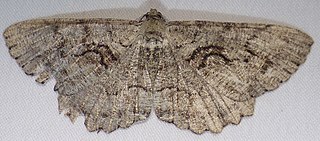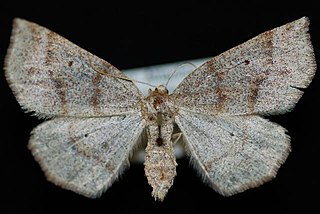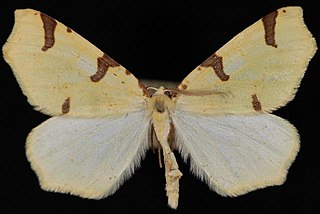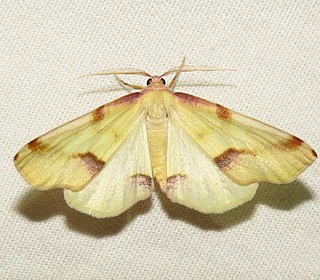
Cymatophora is a genus of moths in the family Geometridae erected by Jacob Hübner in 1812. It is monotypic, being represented by the single species, the giant gray moth. It is found mostly in the south-eastern United States. It is found in North America.
Eumacrodes is a monotypic moth genus in the family Geometridae described by Warren in 1905. Its only species, Eumacrodes yponomeutaria, first described by Achille Guenée in 1858, is found in the Caribbean and North America.
Ptychamalia is a monotypic moth genus in the family Geometridae described by Prout in 1932. Its only species, Ptychamalia dorneraria, was first described by William Barnes and James Halliday McDunnough in 1913. It is found in North America.

Snowia is a monotypic moth genus in the family Geometridae. Its only species, Snowia montanaria, is known from North America. Both the genus and species were first described by Berthold Neumoegen in 1884. It is found in North America.
Pseudhapigia is a monotypic moth genus of the family Notodontidae. Its only species, Pseudhapigia brunnea, is found in North America including its type location in Guadalajara, Mexico. The genus and species were first described by William Schaus in 1901.
Didugua is a monotypic moth genus of the family Notodontidae. Its only species, Didugua argentilinea, the silvered prominent, is found in North America. Both the genus and species were first described by Herbert Druce in 1891.

Chlorosea roseitacta is a species of emerald moth in the family Geometridae. It is found in North America.

Metarranthis duaria, the ruddy metarranthis, is a species of geometrid moth in the family Geometridae. It is found in North America.

Lethe creola, the creole pearly-eye, is a species of brush-footed butterfly in the family Nymphalidae. It is found it the United States from North Carolina and central Georgia west to eastern Oklahoma and eastern Texas. Some authorities include this species in the genus Enodia as Enodia creola.
Gonodonta nitidimacula is a species of fruit-piercing moth in the family Erebidae. It is found in North America.
Condica temecula is a species of moth in the family Noctuidae. It was first described by William Barnes in 1905 and it is found in North America.

Gluphisia severa, the banded pebble, is a species of moth in the family Notodontidae. It was first described by Henry Edwards in 1886 and it is found in North America.
Glena interpunctata is a species of moth in the family Geometridae first described by William Barnes and James Halliday McDunnough in 1917. It is found in North America.
Crinodes biedermani is a species of moth in the family Notodontidae. It was first described by Skinner in 1905 and it is found in North America.
Speranza pallipennata is a species of moth in the family Geometridae first described by William Barnes and James Halliday McDunnough in. It is found in North America.

Protitame virginalis, the virgin moth, is a moth in the family Geometridae. The species was first described by George Duryea Hulst in 1900. It is found in North America.
Hulstina wrightiaria, or Wright's hulstina, is a species of geometrid moth in the family Geometridae. It is found in North America.

Neoterpes trianguliferata, the canary thorn, is a moth in the family Geometridae. The species was first described by Alpheus Spring Packard in 1871. It is found in North America.

Plagodis serinaria, the lemon plagodis, is a species of geometrid moth in the family Geometridae. It is found in North America.
Hulstina imitatrix is a species of geometrid moth in the family Geometridae. It is found in North America.








